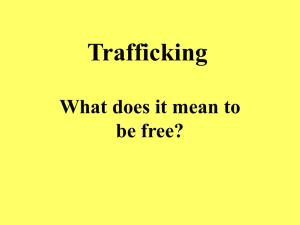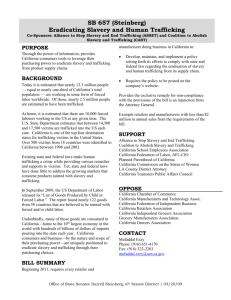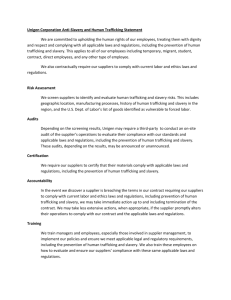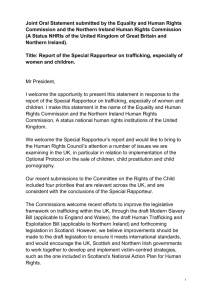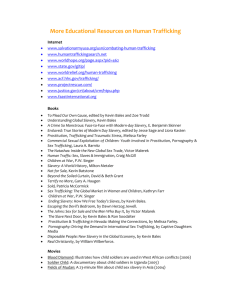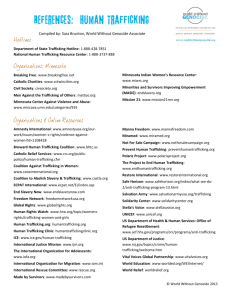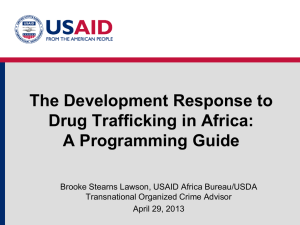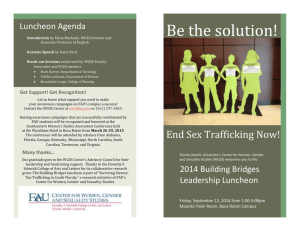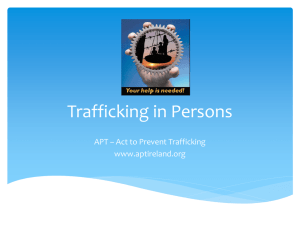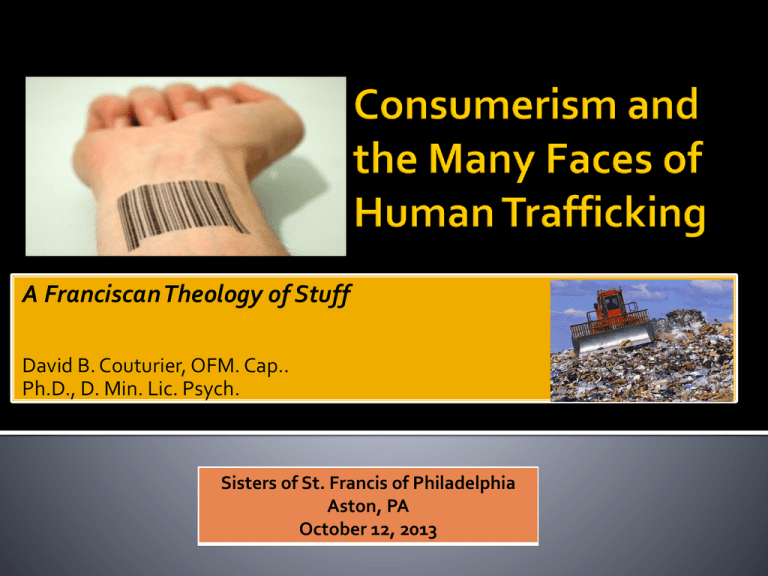
A Franciscan Theology of Stuff
David B. Couturier, OFM. Cap..
Ph.D., D. Min. Lic. Psych.
Sisters of St. Francis of Philadelphia
Aston, PA
October 12, 2013
A child so unloved
That she cannot cry no more
Markings on her face
That she didn’t have before
She tried but couldn’t smile
Happy she was not
Her father often traded her
Sometimes she was bought
A child of human trafficking
To men she didn’t know
They used her and abused her
and wouldn’t let her go
Her heart was numb with pain
She did what she was told
Knowing if she didn’t
It was food they would withhold
A life so full of suffering
and games adults would play
She was just a prostitute
Who daily had to pay
A life she wish she could deny
An escape to young to take
A numbness throughout her body
A world so full of hate
A life that’s really dead inside
Scars that will never heal
A mind that cannot comprehend
The trauma of this ordeal
Then one day it happened
She got raided by the police
Taken some place safe
Then finally released
To go some place and heal
Her battle wounds and scars
Start herself a new life
Underneath the stars
© Kym Erickson. All rights reserved, 9 months ago
• Through the use
of force,
coercion,
abduction,
fraud,
deception,
abuse of power
or vulnerability,
or giving
payments or
benefits to a
person who is in
control of the
victim.
The Purpose
The
recruitment,
transportation,
transfer,
harboring or
receipt of a
human person.
The Means
The Act
•
• For the
purpose of
exploitation…
to include the
prostitution
of others,
forced labor,
slavery or
similar
practices
Close to 30 million slaves in the
world;
17,000 to 20,000 foreign nationals
trafficked into the US each year;
200,000 “domestic slaves” living
and working in the US.
… is the second most profitable form of
transnational crime in the world after the sale
of drugs, more profitable than the sale of arms.
… it is a diversified network of corporate
enterprises that exists in almost every trade
imaginable and it uses some of our most
cherished and respected industries to
advance its most desperate forms of
exploitation.
Human trafficking is one of the
“dirty little secrets” of Philadelphia’s suburbs.
(August 6, 2013)
At the end of 2010, it was estimated that the
4% of the world’s 30 million people who were
used as trafficked sex slaves generated
$38.7 billion dollars in profits for those
managing the human slave industry.
We think we know the face of human
trafficking.
Dr. Jefferson Calimlin, MD.
Dr. Elnora Calimlin, MD.
Milwaukee Wisconsin physicians.
Americans are expected to spend upwards of
$8 billion dollars on Halloween:
2.87 billion on costumes;
1.65 billion on decorations;
$2.35 billion on candy, most of it chocolate
and most of it made by
80% of chocolate comes from the cocoa plants
of Ghana and the Ivory Coast of Africa.
43% of chocolate comes
from here….
In 2001, the Chocolate Manufacturers
Association agreed to prohibit child trafficking
in the cocoa industry by the year 2008.
How did they do?
“Consumer pressure has been insufficient to
spark industry collaboration to address child
labor in the cocoa supply chain.”
“Demand for ‘fair trade’ chocolate remained
relatively small.”
Elliot J. Schrage and Anthony P. Ewing,
“The Cocoa Industry and Child Labour,” (Summer, 2005).
Kevin Bales: each and every day before we
ever get to work, we are “eating, wearing,
walking and talking slavery.”
“Every one of us, every day, touches, wears and
eats products tainted with slavery. Slaverymade goods and commodities are everywhere
in our lives.”
-Kevin Bales, The Slave Next Door (2009).
“ The truly dark side of human trafficking, that
which gives currency and cover to these
heinous individual acts, is the ongoing
corporate expression of trafficking and
exploitation through the supply chains that
feed modern human slavery.”
-David B Couturier, OFM. Cap.
“ Unnoticed damage is, of course, not
nonexistent damage.”
- David T. Schwartz, Consuming Choices: Ethics in a Global Consumer Age (2010), p. 44
“Even though Franciscans don’t often think of
themselves as consumers and our vow of
poverty often keeps us from identifying with the
streams and currents of modern economic life,
the fact is that we are indeed consumers who
spend and spend considerably… the question we
need to ask ourselves is “how do we begin to see
ourselves as ‘ethical consumers.’”
What happens when we turn off the music and
inspect the long chains that supply our shirts and
sneakers, our tee shirts and blouses and realize
that our low prices, everyday, really come at a
high price and that price is the slave labor of
men, women and children?
Tazreen Fashions Factory in Bangladesh
Faded Glory
“An extensive examination by the NY Times reveals how
the inspection system intended to protect workers and
ensure manufacturing quality is riddled with flaws. The
inspections are often so superficial that they omit the
most fundamental workplace safeguards like fire
escapes. And even when inspectors are tough, factory
managers find ways to trick them and hide serious
violations, like child labor or locked exit doors.
Dangerous conditions cited in the audits frequently take
months to correct, often with little enforcement or
follow-through to guarantee compliance.”
-
Stefanie Clifford and Steven Greenhouse, “Fast and Flawed Inspections of Factories Abroad,”
NY Times (9/2/13)
“A central problem, the first owner told me, is the rapid turnaround big
retailers like Walmart demand when they put in orders for tens of thousands
of T-shirts or shorts. Since his factory isn’t able to make all the garments in
time, he has to send some of the work to smaller producers. “I can’t do it
officially,” he said, “but unofficially, I can.”
Unauthorized subcontracting to smaller, uninspected factories is not
supposed to happen, but it remains an entrenched practice. It is a primary
reason safety guidelines that apply to bigger contractors have not
prevented the hundreds of worker deaths in fires and building collapses in
facilities like Rana Plaza, which crumbled last April killing 1,129 people.
The factory owners admitted that what they were doing was wrong. But
they said Western clothing companies were also culpable because they
often award contracts to manufacturers that they know do not have
enough machines and employees to do the job. “
NY Times, September 15, 2013.
Vermont Sen. Bernie Sanders,
an independent, tweeted a
startling statistic to his followers
on July 22, 2012:
"Today the Walton family of
Walmart own more wealth than
the bottom 40 percent of
America."
Who’s saving the money? Who’s living better?
6 people > 120, 000, 000 people
“According to the complaint, Signal and its agents
defrauded 500 guest workers from India out of tens of
thousands of dollars in exorbitant ‘recruitment fees,’
falsely promising the assistance in obtaining permanent
residence in the US. Instead, these workers were
trafficked to the company’s facilities in Mississippi and
Texas, forced to live in overcrowded, unsanitary labor
camps that threatened their health and psychological
well-being. These workers were threatened with
financial ruin, arrest and serious immigration
problems if they did not acceded to the company’s
strategies.”
The Polaris Project estimates that
there are
more individuals in slavery
today
than at the height of the transAtlantic slave trade of the 17th,
18th and 19th centuries.
How many slaves work for you?
http://blog.madeinafreeworld.com
A friar asked:
“Do you think Americans really care under what
conditions the products they buy are made, as
long as the quality is good, the goods are
readily available and the price is cheap?”
Long before we get to talks
like these, we are children
immersed in a culture of
consumption, such that every
aspect of our lives is touched
by the ‘need and greed’
mentality
of
modern
aggressive consumerism.
What is so troubling about consumerism is that
it proceeds from a reductionist philosophy of the
human person, one that narrowly defines men
and women by their economic potential and
the satisfaction of their material wants.
Consumerism reduces us to what we can earn,
spend and purchase.
Do I care whether the products I buy or use
are tainted with human slavery?
Are the price, convenience and availability
of goods more important to me than the
possibility that these goods might be the result
of child and slave labor?
How much time and effort am I willing to
invest in determining whether a product is the
result of trafficked labor?
How willing am I to make this problem of
human trafficking upfront and personal in my
life?
How willing am I to work with others to
eradicate slave labor from my home and
dinner table?
An imperceptible good is not
an inconsequential good.
- David B. Couturier, OFM. Cap.
Inspire
Perspire
Justice
Work
Conspire
“the divine conspiracy of love”
1. They must verify their product supply chains and evaluate the
risks of human trafficking and slavery at every step. They have to
disclose whether or not this verification was conducted by an
outside, third-party, agent or not.
2. They have to conduct audits of all their suppliers to evaluate
their suppliers’ compliance with the company’s standards for
trafficking and slavery in their supply chains. The disclosure to the
state (and on their company website) has to specify whether the
audit was done independently and whether it was conducted
unannounced. (A good model of this effort, by the way, can be
found on the Hewlett-Packard website.)
3. The law requires direct suppliers to certify that the materials
incorporated into the product comply with the laws regarding
slavery and human trafficking of the country or countries in which
they are doing business.
4. The companies must maintain internal
accountability standards and procedures for
employees or contractors failing to meet
company standards regarding slavery and human
trafficking.
5. The companies must provide training to
company employees and to management, who
have direct responsibility for supply chain
management, particularly with respect to
mitigating the risks within their supply chains of
products.
Information center on ways to press for greater
private sector involvement in the fight against
human trafficking at both the company and
industry levels.
No one in the history of the Church has done
more to inspire respect for the dignity of each
and every person, no matter what class, race or
culture one belongs to, than did Francis of
Assisi.
We now live in a “disenchanted world.”
At one moment in time, at one instant in history, out of the
frozen silence of billions of years, God decided to speak:
In the beginning was the Word
And the Word was with God
And the Word was God…
And the Word became flesh.
(John 1:1)
Human trafficking has been facilitated by a crass
and course disenchantment of the world and
everything in it, reducing God’s great creation to
nothing more than stuff.
… is that we buy and sell,
what we collect and store,
what we pitch and toss
away. Stuff becomes our
impersonal and
disconnected refuse. It is
hoarded, piled up in our
closets and hidden away in
our basements. It is what
gets buried and made
invisible in our landfills.
Instead, our consumerist mindset
has transformed creation into
matter and we have made it into
stuff.
Enchantment has become
waste management.
We have done it to nature and now
we are doing it to humankind.
We replace the infinity of God
with the infinity of goods.
We too must demonstrate a
similar holy madness.
Human trafficking is a sin against
the luxurious abundance and
infinite goodness of God.
This is the trick and this is the treat of
our Franciscan politics, the work of
reclaiming all God’s creatures into the
superabundant and enchanted divine
conspiracy of love, which we have
seen and heard in Jesus Christ, who is
Lord, forever and ever. Amen!

